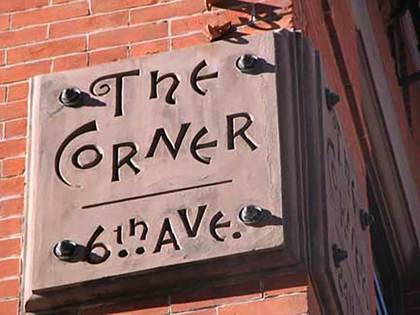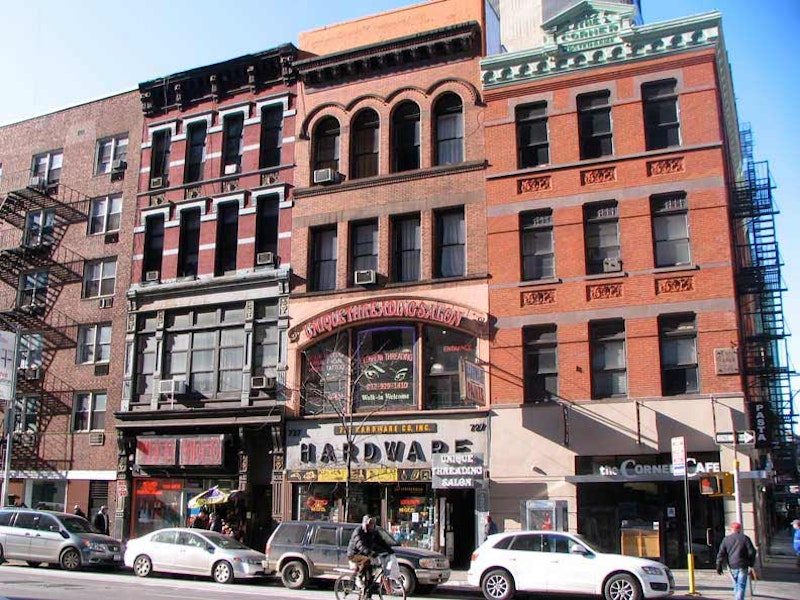I was swaying up 6th Ave. on a January Sunday, bending against unending winter winds, on the way to the Home Depot to buy lightbulbs. I walked 6th Ave. for the first time in a while, and noticed that it has become as bland and anodyne a stretch of road as is humanly possible in a city of the age of New York. As one Facebook commentator wrote me, it looks like Houston.
Sixth is now lined on both sides between 24th and 29th Sts. with a nearly unbroken line of high-rise condominiums, with banks facing the sidewalks. As the businesses I frequented, record stores where I could once emerge with stacks of wax and pay less than $50, and bookstores where I could buy enough reading material to last the entire week before going back for more, begin to vanish forever, casualties of gouging rents, they’re replaced by banks and cheap-goods chains, increasingly the only tenants who can afford space. Walking south, at 24th St. I spied some old pals I hadn’t run into since first doing photography for my website, Forgotten New York.
In contrast to the stretch of blocks north of it—where most buildings are between five and 10 years old—6th Avenue between W. 23rd and 24th presents three buildings that go back to the mid- to late-1880s. Amazingly, they look the same as they did then, except for changes made on the ground floors.

John Koster and Albert Bial were German immigrants who ran a series of entertainment establishments and concert halls in the late-19th century. They opened their first venue a block south of here, at 6th Ave. and 23rd St., in 1879, a beer garden with occasional performances. Two years later Koster & Bial opened a second establishment at 115-117 W. 23rd; this one was a theater offering song and comedy, a precursor to vaudeville. K & B remained in the 23rd St. area until 1892, when they moved uptown, as much of NYC’s entertainment business then was doing, to W. 34th, where they ran a larger theater under the aegis of Oscar Hammerstein Sr. until their deaths in 1895 and 1897 respectively. The uptown Koster & Bial’s property was purchased by R.H. Macy’s in 1901, and The World’s Biggest Store remains on the property today.


“The Corner” building at 6th Ave. and 24th was constructed from 1886-1887 and served as K&B’s offices, also containing a beer bottling business. It was part of the K&B empire for only a short time. The print above, from the NYPL archives, shows it in 1892, and it looks remarkably the same today.

Any discussion of “The Corner” building is incomplete without mentioning Billy’s Topless, which held down the storefront for nearly three decades before a change in zoning ultimately doomed it in 1999. Says Jeremiah's Vanishing NY: For over two decades, Billy’s was a neighborhood bar. They served a free sterno-heated buffet (that no one ever touched). The customers and the dancers knew each other, chatted together, and no one got hustled, girls from the Coney Island Sideshow danced at Billy’s, tattoos and all. The stars of the new burlesque paid the rent and tried out new routines at Billy’s. Each girl was unique, some beautiful, some boring, while others looked like something straight out of Diane Arbus. Some girls from the Fashion Institute of Technology would dance at Billy’s on their lunch hour to help pay school bills. Billy’s is a bagel shop now.

The building adjacent is just another glassy storefront but a few years ago it was this old-school hardware store. But if you look at the print again, you can see the second-floor arch, which is still intact. It’s likely the hardware joint was done in not only by rising rent but by the gargantuan Home Depot a block away on 23rd St.

A brutal look north on 6th Ave., so you can see what it has become, as Manhattan becomes as bland as Maypo.
—Kevin Walsh is the webmaster of the award-winning website Forgotten NY, and the author of the books Forgotten New York (HarperCollins, 2006) and also, with the Greater Astoria Historical Society, Forgotten Queens (Arcadia, 2013)

